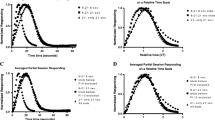Abstract
Results of a survey sent to members of the editorial boards of five behavior-analytic journals in 1990 indicated that there was no consensus among respondents with respect to whether delayed events can function as reinforcers (Schlinger, Blakely, Fillhard, amp; Poling, 1991). Since that time, several studies with nonhuman animals have demonstrated that events delayed by at least several seconds can increase the probability of occurrence of the responses that produce them. To determine the relative number of contemporary behavior analysts who nonetheless believe that reinforcers must immediately follow the responses that produce them, the present study replicated the procedures used by Schlinger et al., with similar results. That is, respondents did not agree with respect to whether delayed events could be reinforcers.
Similar content being viewed by others
References
Alberto, P. A., & Troutman, A. C. (2009). Applied behavior analysis for teachers (8th ed.). New York: Merrill.
Anger, D. (1963). The role of temporal discriminations in the reinforcement of Sidman avoidance behavior. Journal of the Experimental Analysis of Behavior, 6, 477–506.
Bachmann, D. P., Elfrink, J., & Vazzana, G. (2000). E-mail and snail mail face off in rematch. Marketing Research, 11, 10–15.
Chance, P. (2006). Learning and behavior (5th ed.). Belmont, CA: Wadsworth Thomson Learning.
Cobanoglu, C., Warde, B., & Moreo, P. J. (2001). A comparison of mail, fax, and web-base survey methods. International Journal of Market Research, 43, 441–452.
Cooper, J. O., Heron, T. E., & Heward, W. L. (2007). Applied behavior analysis (2nd ed.). Columbus, OH: Merrill.
Critchfield, T. S., & Kollins, S. H. (2001). Temporal discounting: Basic research and the analysis of socially important behavior. Journal of Applied Behavior Analysis, 34, 101–122.
Critchfield, T. S., & Lattal, K. A. (1993). Acquisition of a spatially defined operant with delayed reinforcement. Journal of the Experimental Analysis of Behavior, 59, 373–387.
Fantino, E., & Logan, C. A. (1979). The experimental analysis of behavior. A biological perspective. San Francisco: Freeman.
Green, L., & Myerson, J. (2004). A discounting framework for choice with delayed and probabilistic rewards. Psychological Bulletin, 130, 767–792.
Herrnstein, R. J., & Hineline, P. N. (1966). Negative reinforcement as shock-frequency reduction. Journal of the Experimental Analysis of Behavior, 9, 421–430.
Johnston, J. M., & Pennypacker, H. S. (2009). Strategies and tactics of behavioral research (3rd ed.). New York: Routledge.
Kazdin, A. E. (2001). Behavior modification in applied settings. Belmont, CA: Wadsworth Thomson Learning.
Lattal, K. A., & Gleeson, S. (1990). Response acquisition with delayed reinforcement. Journal of Experimental Psychology: Animal Behavior Processes, 16, 27–39.
Lattal, K. A., & Metzger, B. (1994). Response acquisition by Siamese fighting fish (Beta splendens) with delayed visual reinforcement. Journal of the Experimental Analysis of Behavior 61, 35–44.
Leslie, J. C., & O’Reilly, M. F. (2003). Behavior analysis: Foundations and applications to psychology. New York: Psychology Press.
Malott, R. W. (2008). Principles of behavior analysis (6th ed.). Upper Saddle River, NJ: Prentice Hall.
Martin, G., & Pear, J. J. (2007). Behavior modification: What it is and how to do it (8th ed.). Englewood Cliffs, NJ: Prentice Hall.
Merriam-Webster’s Collegiate Dictionary. (2009). Immediately. Retrieved from http://www.merriam-webster.com/
Miltenberger, R. G. (2008). Behavior modification: Principles and procedures (4th ed.). Belmont, CA: Wadsworth Thomson Learning.
Moore, J. (1995). Some historical and conceptual relations among logical positivism, behaviorism, and cognitive psychology. In J. T. Todd & E. K. Morris (Eds.), Modern perspectives on B. F. Skinner and contemporary behaviorism (pp. 51–74). Westport, CT: Greenwood.
Moore, J. (2008). Conceptual foundations of radical behaviorism. Cornwall on Hudson, NY: Sloan.
Oxford English Dictionary. (2009). Immediately. Retrieved from http://www.oed.com/
Pear, J. J. (2001). The science of learning. Philadelphia: Psychology Press.
Pierce, W. D., & Cheney, C. D. (2008). Behavior analysis and learning (4th ed.). New York: Psychology Press.
Reeve, L., Reeve, K. F., Brown, A. K., Brown, J. L., & Poulson, C. L. (1992). Effects of delayed reinforcement on infant vocalization rate. Journal of the Experimental Analysis of Behavior, 58, 1–8.
Roll, J. M., Reilly, M. P., & Johanson, C. E. (2000). The influence of exchange delays on cigarette versus money choice: A laboratory analog of voucher-based reinforcement therapy. Experimental and Clinical Psychopharmacology, 8, 366–370.
Sarafino, E. P. (2004). Behavior modification: Principles of behavior change. Long Grove, IL: Waveland.
Schlinger, H. D., & Blakely, E. (1994). The effects of delayed reinforcement and a response-produced auditory stimulus on the acquisition of operant behavior in rats. The Psychological Record, 44, 391–409.
Schlinger, H. D., Blakely, E., Fillhard, J., amp; Poling, A. (1991). Defining terms in behavior analysis: Reinforcer and discriminative stimulus. The Analysis of Verbal Behavior, 9, 153–161.
Schlinger, H. D., & Poling, A. (1998). Introduction to scientific psychology. New York: Plenum.
Skinner, B. F. (1945). The operational analysis of psychological terms. Psychological Review, 52, 268–277.
Skinner, B. F. (1953). Science and human behavior. New York: Macmillan.
Skinner, B. F. (1957). Verbal behavior. Englewood Cliffs, NJ: Prentice Hall.
Stromer, R., McComas, J. J., & Rehfeldt, R. A. (2000). Designing interventions that include delayed reinforcement: Implications of recent laboratory research. Journal of Applied Behavior Analysis, 33, 359–371.
Sutphin, G., Byrne, T., & Poling, A. (1998). Response acquisition with delayed reinforcement: A comparison of two-lever procedures. Journal of the Experimental Analysis of Behavior, 69, 17–28.
Wilkenfield, J., Nickel, M., Blakely, E., amp; Poling, A. (1992). Acquisition of leverpress responding in rats with delayed reinforcement: A comparison of three procedures. Journal of the Experimental Analysis of Behavior, 58, 431–443.
Williams, A. M., & Lattal, K. A. (1999). The role of the response-reinforcer relation in delay-of-reinforcement effects. Journal of the Experimental Analysis of Behavior, 71, 187–194.
Author information
Authors and Affiliations
Corresponding author
Additional information
The reported data were collected as part of the master’s thesis of Kelly Bradley. We thank all respondents for their help.
Rights and permissions
About this article
Cite this article
Bradley, K.P., Poling, A. Defining Delayed Consequences as Reinforcers: Some Do, Some Don’t, and Nothing Changes. Analysis Verbal Behav 26, 41–49 (2010). https://doi.org/10.1007/BF03393081
Published:
Issue Date:
DOI: https://doi.org/10.1007/BF03393081




